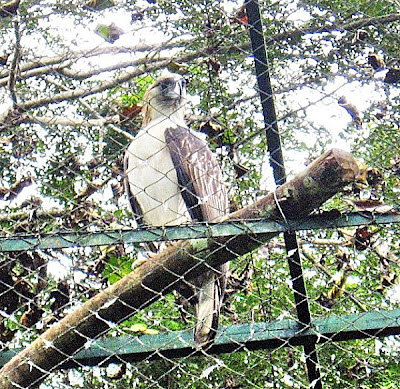 |
| Taal Volcano’s crater lake and Vulcan Point |
After a delightful Filipino breakfast at Balai Isabel’s restaurant, Bernard, George (Bernard’s son), Bernard’s niece and I made ready for our scheduled hike up, via the Daang Kastila Trail, to the view point of Taal Volcano. Aside from other resort guests, we were traveling with distinguished company, as joining our trek to the volcano were members of the Mt. Everest team including the 3 Pinay ladies who conquered Mt. Everest just a year ago – Ms. Janet Belarmino, Ms. Carina Dayondon and Ms. Noelle Wenceslao – plus Mr. Fred Jamili, member of the First Philippine Mt. Everest Expedition Team’s technical and support group. The four, together with Mr. Erwin “Pastor” Emata and Dr. Ted “Omar” Esguerra, were slated to join the 2008 6th Hillary-Tenzing Mt. Everest Marathon in Nepal, tagged as the highest marathon in the world. This 42-km., basically downhill race starts from the Mt. Everest base camp at the Nepal or south side (altitude: 17,149 ft.), to the town of Namche Bazar (altitude: 11,300 ft.). The volcano trek will serve as a warmup to that event.
 |
| The Welcome Center |
This was to be my third visit to the volcano and my second to the viewpoint (the other was a trek to the crater lake itself). To get to Volcano Island, we used a number of the resort’s 32 accredited motorized bancas. Our 30-min. trip again took us around the island, past the 311-m. high Mt. Binintiang Malaki, the island’s highest point seemingly featured on most Taal Volcano postcards like an island but actually connected to the real Volcano Island. We soon arrived at the open-air Welcome Center and rested for a while prior to our hike.
From here, it was all 45 mins. (1.7 kms.) of hiking, first along the beach, then into a shady forest and, on our last leg, up a steep, dusty and treeless trail up to the Crater Lake viewpoint. Steam vents, emitting a sulfurous odor, can be encountered along the way. The viewpoint, actually just a makeshift hut, was a cool welcome relief for its shade and its magnificent bird’s eye view of the beautifully azure and seemingly peaceful, 2-km. wide crater lake with its small island called Vulcan Point, a view not seen in any view point in Tagaytay City. At the northeast edge of the lake are vents that effuse volcanic steam. Mt. Makulot, the highest mountain in Batangas, can be seen in the distance. The trek back, to the Welcome Center and our boats, was faster but very slippery. Back at our boats, we were soon on our way back to the resort where a welcome lunch awaited us.









































.jpg)
























